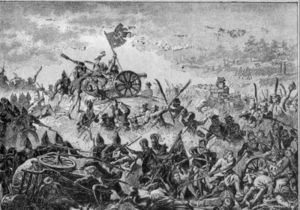
Battle of Raclawice
Encyclopedia

Poland
Poland , officially the Republic of Poland , is a country in Central Europe bordered by Germany to the west; the Czech Republic and Slovakia to the south; Ukraine, Belarus and Lithuania to the east; and the Baltic Sea and Kaliningrad Oblast, a Russian exclave, to the north...
Kościuszko Uprising
Kosciuszko Uprising
The Kościuszko Uprising was an uprising against Imperial Russia and the Kingdom of Prussia led by Tadeusz Kościuszko in Poland, Belarus and Lithuania in 1794...
against Russia. It was fought on April 4, 1794 near the village of Racławice in Lesser Poland
Lesser Poland
Lesser Poland is one of the historical regions of Poland, with its capital in the city of Kraków. It forms the southeastern corner of the country, and should not be confused with the modern Lesser Poland Voivodeship, which covers only a small, southern part of Lesser Poland...
.
The Polish forces prepared for the battle were relatively small. The Polish Order of Battle was as follows:
| unit | supperior | soldiers | |||||||||||
|---|---|---|---|---|---|---|---|---|---|---|---|---|---|
| 2 battalions | Infantry Regiment of Czapski | 400 bayonettes | |||||||||||
| 2 battalions | Infantry Regiment of Wodzicki | 400 bayonettes | |||||||||||
| 2 battalions | Infantry Regiment of Ożarowski | 400 bayonettes | |||||||||||
| 1 battalion | Infantry Regiment of Raczyński | 200 bayonettes | |||||||||||
| 10 squadrons of cavalry | under Antoni Madaliński Antoni Madalinski Antoni Madaliński – Polish Lieutenant General, commander of 1st Greater Polish National Cavalry Brigade during Kościuszko Uprising.... |
400 sabres | |||||||||||
| 10 squadrons of cavalry | under Magnet | 400 sabres | |||||||||||
| 4 cavalry squadrons | under Biernacki | 160 sabres | |||||||||||
| 2 auxiliary cavalry squadrons | Duchy of Württemberg | 80 sabres | |||||||||||
| 2440 men altogether | |||||||||||||
In addition, Lesser Poland fielded approximately 2,000 peasants armed with war scythe
War scythe
A war scythe is a kind of improvised pole weapon, similar to a fauchard, usually created from standard scythes. The blade of the scythe is transformed so as to extend upright from the pole, thus forming an infantry weapon practical both in offensive actions against infantry and as a defensive...
s and pikes, as well as 11 cannons. The outcome of the battle was a tactical Polish victory, with Kościuszko defeating the numerically inferior enemy. However, his forces were too small to start a successful pursuit and the Corps of General Denisov evaded destruction and continued to operate in Lesser Poland.
The victory was subsequently promoted in Poland as a major success and helped in starting the Kościuszko Uprising
Kosciuszko Uprising
The Kościuszko Uprising was an uprising against Imperial Russia and the Kingdom of Prussia led by Tadeusz Kościuszko in Poland, Belarus and Lithuania in 1794...
in other areas of Poland
Poland
Poland , officially the Republic of Poland , is a country in Central Europe bordered by Germany to the west; the Czech Republic and Slovakia to the south; Ukraine, Belarus and Lithuania to the east; and the Baltic Sea and Kaliningrad Oblast, a Russian exclave, to the north...
and the Warsaw Uprising of 1794
Warsaw Uprising (1794)
The Warsaw Uprising of 1794 was an armed Polish insurrection by the city's populace early in the Kościuszko Uprising. Supported by the Polish Army, it aimed to throw off Russian control of the Polish capital city...
. Also, the participation of peasant volunteers was seen by many as the starting point of the political evolution of Polish peasantry from serfs to equally-entitled citizens of the nation
Nation
A nation may refer to a community of people who share a common language, culture, ethnicity, descent, and/or history. In this definition, a nation has no physical borders. However, it can also refer to people who share a common territory and government irrespective of their ethnic make-up...
.

Artillery
Originally applied to any group of infantry primarily armed with projectile weapons, artillery has over time become limited in meaning to refer only to those engines of war that operate by projection of munitions far beyond the range of effect of personal weapons...
. He also praised Wojciech Bartosz Głowacki, a peasant who was the first to capture the cannon (he is visible in the Matejko's painting, above). He covered it's flame with his hat before it fired. In return he received an award of nobility. Both the red cap worn by his soldiers and the home-made war scythes were later featured on the emblem of the 303rd Polish Fighter Squadron which took part in the Battle of Britain
Battle of Britain
The Battle of Britain is the name given to the World War II air campaign waged by the German Air Force against the United Kingdom during the summer and autumn of 1940...
.
See also
- The Racławice Panorama

